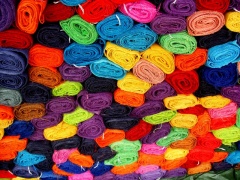Fabrics/cloth/textiles
| Infobox on Fabrics/cloth/textiles | |
|---|---|
| Example of Fabrics/cloth/textiles |  |
| Facts | |
| Origin | Product flow is generally as follows:
|
| Stowage factor (in m3/t) |
|
| Humidity / moisture |
|
| Ventilation | Recommended ventilation conditions: air exchange rate: 6 changes/hour (airing), if the dew point of the external air is lower than the dew point of the hold air. |
| Risk factors | The goods are liable to catch fire. All smoking is prohibited. It is recommended that CO2 be used to extinguish fires. Sensitive to wet damage. |
Fabrics/cloth/textiles
Contents
Description
Textile manufacturing is a major industry. It is based in the conversion of three types of fibre into yarn, then fabric, then textiles. These are then fabricated into clothes or other artifacts. Cotton remains the most important natural fibre, so is treated in depth. There are many variable processes available at the spinning and fabric-forming stages coupled with the complexities of the finishing and colouration processes to the production of a wide ranges of products. There remains a large industry that uses hand techniques to achieve the same results.
Fabrics or textiles are named for the yarns used to make them, e.g. cotton, woolen, silk, linen, hemp, (jute) fabrics. They may consist of natural fibres of either animal or vegetable origin, such as cellulose/viscose, or of manmade fibres, such as polyamides, or of mixtures of these materials. With regard to processing, a rough distinction may be drawn between semi-manufactured and finished articles.
Applications
Fabrics/cloth (generally in the form of yard goods) are further processed to produce textile products or ready-made garments.
Shipment / storage / usage
Due to photomechanical degradation processes, extended exposure to light puts natural and manmade fibres at risk; natural silk, polyamide fibres, jute and ramie are particularly sensitive. Packaging varies depending on processing stage.
Yard goods are wound on cores and sometimes packaged in cartons. The goods undergo thorough checks before being packaged in dry, ventilated rooms. They must not be exposed to intense solar radiation.
Since the goods are strongly hygroscopic and readily absorb moisture, they must be protected from wetness. Moisture absorbed from the surrounding environment or present at the time of packaging (also seawater, rain, condensation water) results in mildew-staining, mold growth, mustiness and even decomposition. The holds/containers must be dry and clean. The stowage space must be away from heat sources.
Favorable travel temperature range: 0 - 30°C. Optimum travel temperature: 20°C ± 5°C.
Exposure to excessively high temperatures cause creases and shrinkage. At temperatures > 30°C and humidities > 30%, wool and natural silk are at risk of brittleness. At high temperatures and high humidities, viscose material is at particular risk of creasing. With PVC fibres, there is a risk of shrinkage and hardening at high temperatures. Excessively low temperatures result in loss of strength.
Risk factors
- Self-heating / Spontaneous combustion
- Moisture / Mould growth
- Odor
- Contamination
- Mechanical influences
- Toxicity / Hazards to health
- Shrinkage / Shortage / Theft
- Insect infestation / Diseases











